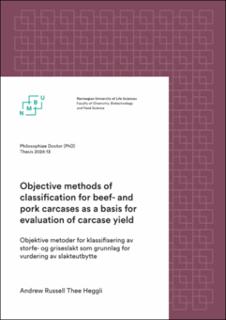| dc.description.abstract | Yield within the meat industry refers to the ratio and weight of tissues from the carcase. Carcase classification gives each carcase grades that determine the price paid for the carcase. Two aspects are especially important in regard to classification; that the grades given are objective, in the sense of being affected as little as possible by human influence, and that the grades accurately reflect the yield. If these two aspects are not well executed producers or abattoirs could potentially suffer a biased or unprecise carcase grading, resulting in an unfair system. Yield has previously been measured by the amount of lean meat in the carcase, both for bovine and porcine carcases. As other aspects of the carcase affect the value of the carcase, new yield variables are needed to account for the variation that lean meat cannot. A new, objective method of classification has partially replaced the previous method of classification by expert human classifiers. The intent of this thesis is to compare the objective classification method for bovine carcases to expert human classifiers, as well as examine the relationship between classification and yield variables more complex than previous literature for both bovine and porcine carcases.
The first study examined the relationship between human classification for conformation and fat cover of bovine carcases and classification from the objective method implemented in Norway since 2019. The new objective method used length measurement of the carcase as well as carcase traits to predict the classification. This method would be cheaper than other popular objective methods within the industry, and thus be of particular interest to smaller abattoirs. The results showed high correlations and low biases for conformation classification, which indicates that the objective classification method functioned well compared to human classifiers. The model functioned poorly when predicting fat cover. The increase in precision when breed information was added was marginal for predicting conformation, but larger for fat.
The second study examined the relationship between classification and yield from bovine carcases. Compared to previous studies, this study used a more complex measurement of yield that, in addition to ratio of fat and bone to carcase weight, included a separation of meat into trimmings of different fat percentages and cuts that can be used without further processing. This analysis also included breed groups consisting of breeds with similar traits. The average percentage residual per breed group was calculated to examine breed as a confounding factor. The analyses in this study would be of particular interest to the producers of the various breeds of cattle, abattoirs and breeding companies. Classification was shown to explain the majority yield variation, and breed had an effect on yield outside of the variation explained by classification.
The third study developed a method of statistically classifying crossbred pigs based on single nucleotide polymorphism (SNP) data. The method used partial least squares (PLS) with SNP data from purebred (PB) pigs as training data. The PLS scores and known aspects of the multivariate normal distribution were used in Partial Least Squares - Quadratic Discriminant Analysis (PLS-QDA) to statistically classify crossbreed (CB) pigs based on their SNP data. The predicted crossbreed combinations were used in Paper IV as independent variables.
The fourth study examined the relationship between classification and yield from finishing pigs. Classification was done using the optical probe HGP7, Hennessy Grading Probe 7 (Hennessy Grading Systems, Auckland, New Zealand. Web page: hennessy-technology.com), with a subset of the sample also classified using the Autofom III (FrontMatec, Kolding, Denmark. Web page: frontmatec.com). The yield variables used as a response were lean meat, fat, and bone percentage, as well as percentage primal cuts. As primal cuts are often sold without further processing, this would be of particular interest to breeding companies and the meat industry as a whole. This study also included cross breed information based on genetic data in the model. The combination of breed information based on genetic data and percentage primal cuts as the response is a novelty within the literature. The results showed that classification explains variation in lean meat and fat to a degree in line with previous literature, but poorly explains variation in primal cut percentages. Breed varied in its significance in regard to the various yield measurements used in the study. | en_US |

